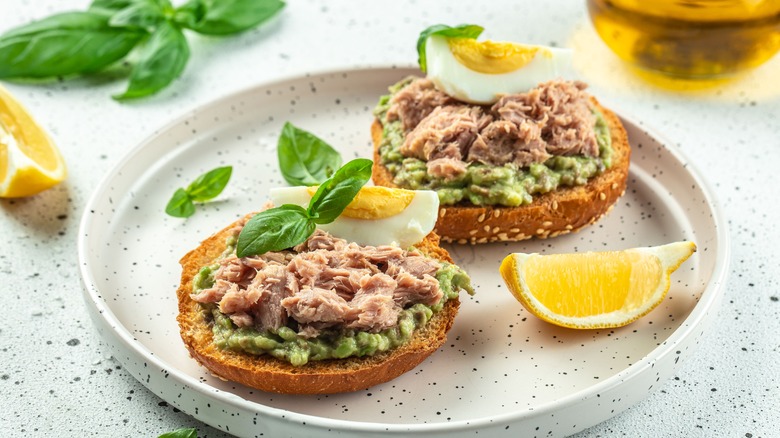The Actual Difference Between Tuna Canned In Water Vs Oil
If you're not incorporating canned tuna into your diet, then you're missing out on one of the most inexpensive, nutrient-packed foods on store shelves. It's loaded with vitamins and minerals, but as with most store-bought fish, there are a handful of things to watch out for when purchasing it, including checking how it was caught and how it's stored. Canned tuna is either packed in oil or water, and the storage method does impact the fish.
Tuna that's stored in water is going to have fewer calories and less fat than the kind stored in oil. That's because oil is loaded with fats that infuse into the fish as it sits in the can. Tuna in oil has more than double the fat of tuna in water. For a standard 4-ounce serving, you can expect tuna in water to have only about 3.6 grams of fat, while tuna in oil will have 9.2 grams. This could especially make a difference if you're preparing tuna salad, which already involves high-fat ingredients like mayonnaise. But if you're going for flavor and aren't worried about fat content, the tuna in oil will be your best option.
Tuna in oil versus tuna in water
Yes, the oil tuna is higher in fat, but that also means a richer, more flavorful product, so if you're preparing something like tuna over pasta and want that oil to add flavor to the pasta as well, the oil-based product will be your best bet. While the tuna in oil is higher in fat, it also has substantially more vitamin D than the kind in water, as well as more of certain minerals, like phosphorus and potassium. Though you might think something higher in fat automatically means it's less healthy, the best tuna for you actually depends on what nutritional benefits you're hoping to gain.
The difference between the two might also lie in the type of tuna. "Different species of tuna are chosen for their specific characteristics such as flavor, texture, and fat content, making them more suitable for either oil or water packing," Laura M. Ali, MS, RDN, who is a nutrition consultant for StarKist Co, told Simply Recipes. You're more likely to find albacore tuna, which has a slightly sweeter and milder flavor, in water, but yellowfin tuna, which is leaner and slightly more flavorful, tends to be packed in oil. Ultimately, the core differences between these canned tuna types lie in their nutritional value, flavor, and potentially the type of tuna.

